In this article we present a summary on the exciting Lower Palaeolithic findings from Crete, Greece, which are believed to imply maritime capabilities of early humans before 130,000 B.P. and even as old as 700,000 B.P.

The Plakias stone age project
This Greek-American collaborative project funds research on the Stone Age discoveries around the village of Plakias in southwest Crete (Greece). It began in 2008 with the Plakias Mesolithic Survey where both Mesolithic (11,000– 9000 B.P.) and Lower Palaeolithic sites (1.5 million years–250,000 years ago) were found.
These artifacts not only represent the earliest tools ever discovered on Crete, they also demonstrate very precocious sea faring abilities by our pre-Homo sapiens ancestors. The goal is to fund further archaeological and geological research into these early phases of prehistory in the region.
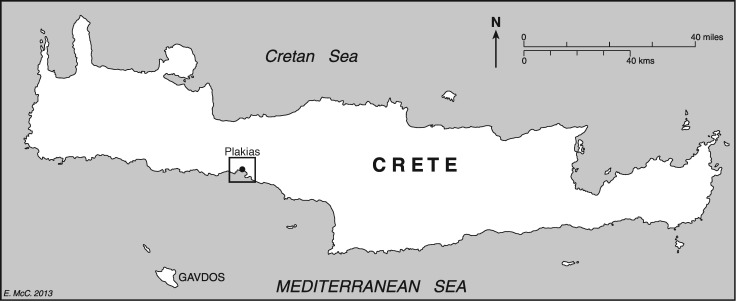
Presently the project’s research focus has two goals. The first is to continue an excavation of a Mesolithic site (Damnoni Excavation) and the second is intensive geological research to acquire absolute dates for the Palaeolithic artifacts found in the area. This is a continuous research project that is exposing dramatic new light on the earliest hominid history on Crete. Donations are used for both the archaeological and geoarchaeological research of the region, including, but not limited to, research supplies, equipment, personnel expenses, and promotion.
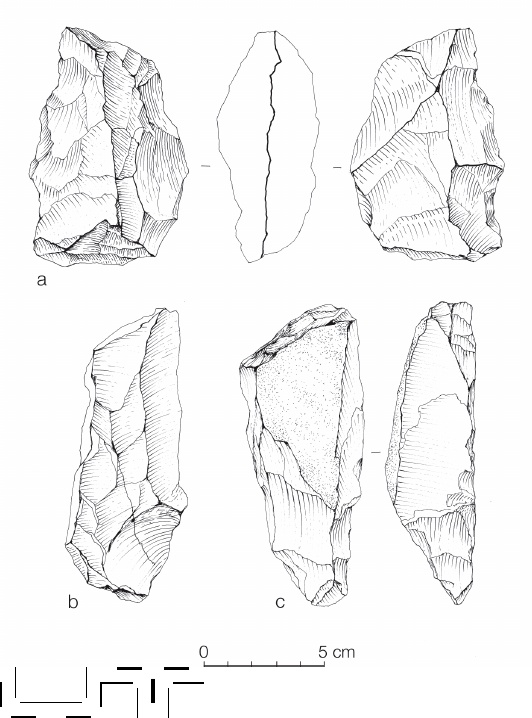
Though claims for pre-Neolithic artifacts on Crete have been made for many decades, the Plakias Survey is the first project to identify Mesolithic and Palaeolithic artifacts in datable geologic contexts. The survey identified twenty-eight sites associated with caves and rock shelters and collected a sample of just over 2,100 lithics attributable to the Mesolithic and the Lower Palaeolithic. Since Crete has been an island for over five million years, these findings have great implications for the history of sea faring in the Mediterranean.
It seemed likely that evidence for the Mesolithic period would be found on Crete because it had been discovered on other islands in the Aegean. Discoveries on Cyprus, Alonnisos, Kythnos, and other islands have shown that a previous model that argued for no pre-Neolithic occupation of the islands was incorrect. Members of the team who work on the Greek mainland developed a Mesolithic site-location model, and it was used to identify areas likely to have early Holocene sites. It was reasoned that if Mesolithic foragers found these smaller islands attractive for subsistence, Crete must also have been a desirable habitat. Crete, however, is a very large island, which raised the question of where to look for the pre-Neolithic. We searched for habitats that were preferred by foragers and that could also preserve their artifacts. The coastal area around Plakias has characteristic environmental features, such as limestone caves, proximity to coastal wetlands, and steep bathymetric drop-off. On the Greek mainland these environmental features were found to be predictive in discovering Mesolithic sites. In addition to using this model, it was possible to involve lithic specialists who were familiar with Mesolithic assemblages.
We examined all caves and rock shelters found near the mouths of fresh water perennial streams and rivers flowing into the Libyan Sea. Scatters of lithic artifacts were found on the slopes directly below the openings. The project’s primary goal was to determine the presence or absence of Mesolithic. Consequently, it was sufficient to make relatively small collections of representative lithics from each site.
Lithic artifacts of Palaeolithic type were collected from nine sites. Palaeolithic artifacts are distinguishable from the Mesolithic ones by their larger size as well as by technological and typological criteria. The tools include bifaces (hand axes) of triangular, sub-triangular, cordiform, and ovate forms; as well as cleavers, and scrapers. The bifaces average ca. 13 cm in length. As noted, the knappers were working with a raw material that had unpredictable flaking qualities; it is often blocky and rough in texture. As a consequence, compromises had to be made. The blanks for the bifaces are side-struck or corner-struck flakes with wide, thick, plain or dihedral platforms. The retouch is invasive, shallow, irregular, and discontinuous. The massive quartz is often of poorer quality than the quartz used in the Mesolithic that is translucent, lustrous and fine-grained.
The Palaeolithic materials resemble the Acheulean sensu lato. Until now there has been no certain evidence of Lower Palaeolithic seafaring in the Mediterranean. The absolute dating of the industry presents a considerable challenge, not the least because of the long period of time that may have elapsed since the occupation of the earliest sites allowing post-depositional natural processes to obscure the record. We used a combination of dating methods including Marine Isotope Stages, Carbon 14, and Soil Maturity Stages.
The dating of the Palaeolithic sites is based on geologic data derived from the study of marine terraces and paleosols, and these data place the Palaeolithic artifacts firmly in the Pleistocene, and probably no later than ca. 130,000 B.P.
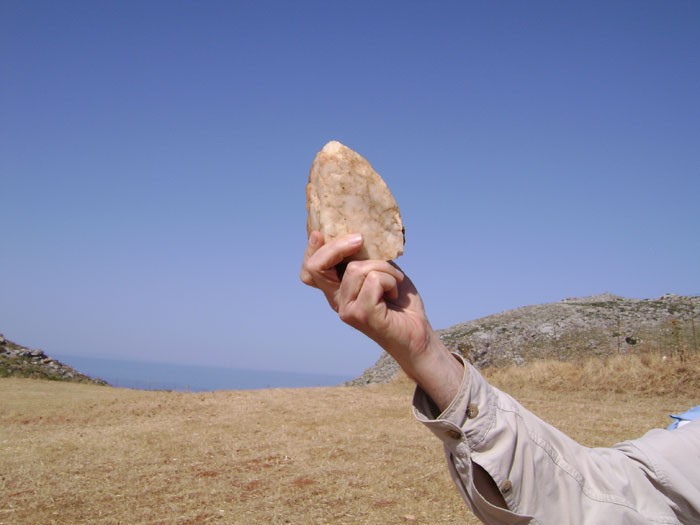
The presence of Lower Palaeolithic sites points to an early period of seafaring in the Mediterranean, with implications for the colonization of Europe by early African hominins. Where did the Plakias Palaeolithic originate? On the present scanty evidence, an African or Near Eastern origin is as likely as an Anatolian or mainland Greek one. Wherever it originated, the Plakias Palaeolithic has implications for our understanding of hominin dispersals. It has been thought that the Acheulean reached Europe via the Near East, passing through Anatolia, and through the Iberian Peninsula directly from Africa, perhaps carried by Homo erectus or Homo heidelbergensis populations. This view of the peopling of Europe by land clearly needs to be rethought in light of the Cretan evidence. While early hominins may have reached Turkey via the Near Eastern corridor, it is clear that there could have been sea routes crossed by long-distance seafarers moving at will throughout the Mediterranean.
Once early hominins reached Crete, was their exploitation of the region continuous or intermittent? What effect did they have on the endemic flora and fauna? As with the Mesolithic, these questions must remain unanswered for the moment, and it is evident from the richness of the finds and the smallness of the survey area that a great deal more research must be done on Crete. Nevertheless, these new discoveries compel us to consider the full significance and potential impact of early seafaring on the peopling of the Mediterranean, Europe and the world.
(Source: http://plakiasstoneageproject.com/project-overview/)
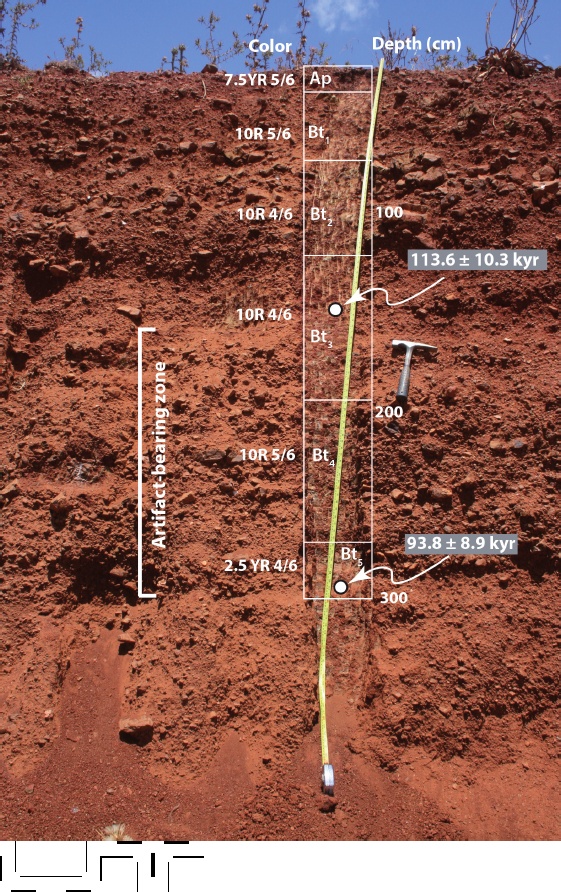
Early humans, possibly even prehuman ancestors, appear to have been going to sea much longer than anyone had ever suspected.
That is the startling implication of discoveries made during the summers of 2008 and 2009 on the Greek island of Crete. Stone tools found there, archaeologists say, are at least 130,000 years old, which is considered strong evidence for the earliest known seafaring in the Mediterranean and cause for rethinking the maritime capabilities of prehuman cultures.
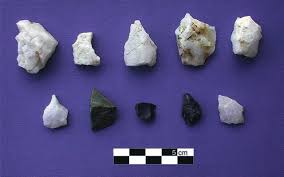
Crete has been an island for more than five million years, meaning that the toolmakers must have arrived by boat. So this seems to push the history of Mediterranean voyaging back more than 100,000 years, specialists in Stone Age archaeology say. Previous artifact discoveries had shown people reaching Cyprus, a few other Greek islands and possibly Sardinia no earlier than 10,000 to 12,000 years ago.
The oldest established early marine travel anywhere was the sea-crossing migration of anatomically modern Homo sapiens to Australia, beginning about 60,000 years ago. There is also a suggestive trickle of evidence, notably the skeletons and artifacts on the Indonesian island of Flores, of more ancient hominids making their way by water to new habitats.
Even more intriguing, the archaeologists who found the tools on Crete noted that the style of the hand axes suggested that they could be up to 700,000 years old. That may be a stretch, they conceded, but the tools resemble artifacts from the stone technology known as Acheulean, which originated with prehuman populations in Africa.
More than 2,000 stone artifacts, including the hand axes, were collected on the southwestern shore of Crete, near the town of Plakias, by a team led by Thomas F. Strasser and Eleni Panagopoulou. She is with the Greek Ministry of Culture and he is an associate professor of art history at Providence College in Rhode Island. They were assisted by Greek and American geologists and archaeologists, including Curtis Runnels of Boston University.
Dr. Strasser described the discovery last month at a meeting of the Archaeological Institute of America. A formal report has been accepted for publication in Hesperia, the journal of the American School of Classical Studies at Athens, a supporter of the fieldwork.
The Plakias survey team went in looking for material remains of more recent artisans, nothing older than 11,000 years. Such artifacts would have been blades, spear points and arrowheads typical of Mesolithic and Neolithic periods.
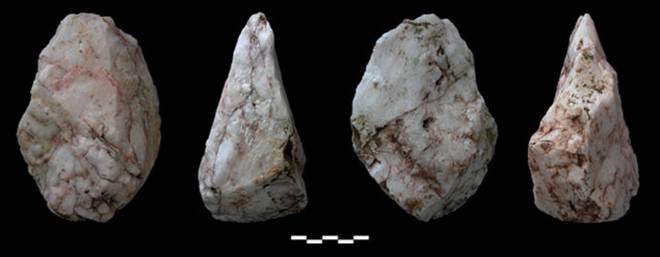
“We found those, then we found the hand axes,” Dr. Strasser said last week in an interview, and that sent the team into deeper time.
“We were flummoxed,” Dr. Runnels said in an interview. “These things were just not supposed to be there.”
Word of the find is circulating among the ranks of Stone Age scholars. The few who have seen the data and some pictures — most of the tools reside in Athens — said they were excited and cautiously impressed. The research, if confirmed by further study, scrambles timetables of technological development and textbook accounts of human and prehuman mobility.
Ofer Bar-Yosef, an authority on Stone Age archaeology at Harvard, said the significance of the find would depend on the dating of the site. “Once the investigators provide the dates,” he said in an e-mail message, “we will have a better understanding of the importance of the discovery.”
Dr. Bar-Yosef said he had seen only a few photographs of the Cretan tools. The forms can only indicate a possible age, he said, but “handling the artifacts may provide a different impression.” And dating, he said, would tell the tale.

Dr. Runnels, who has 30 years’ experience in Stone Age research, said that an analysis by him and three geologists “left not much doubt of the age of the site, and the tools must be even older.”
The cliffs and caves above the shore, the researchers said, have been uplifted by tectonic forces where the African plate goes under and pushes up the European plate. The exposed uplifted layers represent the sequence of geologic periods that have been well studied and dated, in some cases correlated to established dates of glacial and interglacial periods of the most recent ice age. In addition, the team analyzed the layer bearing the tools and determined that the soil had been on the surface 130,000 to 190,000 years ago.
Dr. Runnels said he considered this a minimum age for the tools themselves. They include not only quartz hand axes, but also cleavers and scrapers, all of which are in the Acheulean style. The tools could have been made millenniums before they became, as it were, frozen in time in the Cretan cliffs, the archaeologists said.
Dr. Runnels suggested that the tools could be at least twice as old as the geologic layers. Dr. Strasser said they could be as much as 700,000 years old. Further explorations are planned.
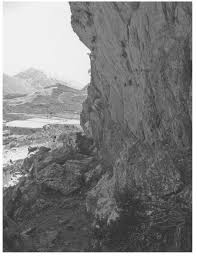
The 130,000-year date would put the discovery in a time when Homo sapiens had already evolved in Africa, sometime after 200,000 years ago. Their presence in Europe did not become apparent until about 50,000 years ago.
Archaeologists can only speculate about who the toolmakers were. One hundred and thirty thousand years ago, modern humans shared the world with other hominids, like Neanderthals and Homo heidelbergensis. The Acheulean culture is thought to have started with Homo erectus.
The standard hypothesis had been that Acheulean toolmakers reached Europe and Asia via the Middle East, passing mainly through what is now Turkey into the Balkans. The new finds suggest that their dispersals were not confined to land routes. They may lend credibility to proposals of migrations from Africa across the Strait of Gibraltar to Spain. Crete’s southern shore where the tools were found is 200 miles from North Africa.
“We can’t say the toolmakers came 200 miles from Libya,” Dr. Strasser said. “If you’re on a raft, that’s a long voyage, but they might have come from the European mainland by way of shorter crossings through Greek islands.”
But archaeologists and experts on early nautical history said the discovery appeared to show that these surprisingly ancient mariners had craft sturdier and more reliable than rafts. They also must have had the cognitive ability to conceive and carry out repeated water crossing over great distances in order to establish sustainable populations producing an abundance of stone artifacts.
(Source: http://www.nytimes.com/2010/02/16/science/16archeo.html)

Abstract Discussions of dispersals of early hominins from Africa assume that Southwest Asia and the Arabian Peninsula were the primary passageways for migrations to Eurasia. The Mediterranean is usually viewed as a barrier to early hominin movements because pre‐sapiens hominins were thought to lack the technical means or the cognitive skills to construct boats. The discovery of early Palaeolithic artefacts in an archaeological survey on the Greek island of Crete challenges this view. Here we show that Palaeolithic artefacts in the Plakias region in southwestern Crete are associated with geological contexts that can be dated to the late Middle or early Late Pleistocene. Because Crete has been separated from the mainland throughout the Pleistocene, the presence of Pleistocene age artefacts there suggests that early hominins were able to cross open water.
(Source: “Dating Palaeolithic sites in southwestern Crete, Greece”, by Thomas F. Strasser, Curtis Runnels, Karl Wegmann, Eleni Panagopoulou, Floyd Mccoy, Chad Digregorio, Panagiotis Karkanas, Nick Thompson)
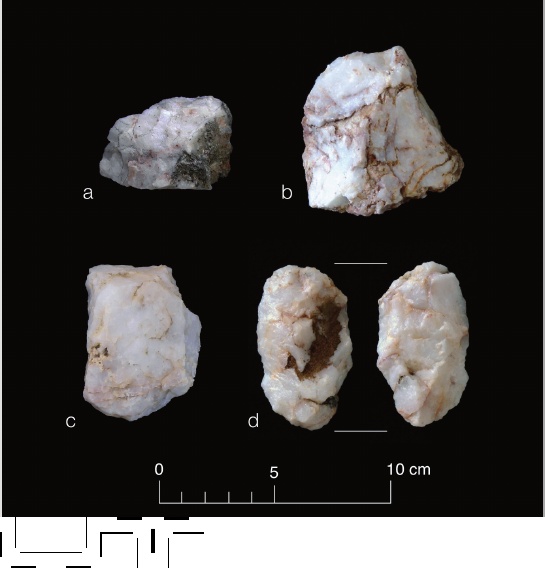
Abstract Lithic artifacts from eight findspots in the Plakias region of southwestern Crete are ascribed to the Acheulean of the Middle Pleistocene on the basis of morphotypological characteristics, geologic contexts, and OSL assays. Considered in a regional context, the Cretan Acheulean is similar to the Acheulean found on sites in both the eastern and western portions of the Mediterranean region that resulted from an “Out of Africa” adaptive radiation of hominins (probably Homo erectus s. l.) that began ca. 0.8 – 1.0 mya. We suggest that hominins may have arrived on Crete in the Middle Pleistocene as part of this hominin dispersal and that open-water crossing, at least in the southern Aegean, may have been involved.

In his recent surveys of the evidence for early humans in the Mediterranean, Broodbank found the evidence for Upper and perhaps Middle Palaeolithic presence on some Aegean islands to be more persuasive than that for the western Mediterranean islands (Broodbank, 2006, 2013:93-96). The discovery in 2008-2009 of Lower Palaeolithic artifacts belonging to the Acheulean Industrial Tradition in southern Crete near the town of Plakias adds to this picture, as do early Palaeolithic finds reported from other
Aegean islands.
Archaeologists and palaeoanthropologists have long argued that hominin dispersals to Eurasia in the Pleistocene followed land routes from Africa (e.g., Anton and Swisher, 2004; Bar-Yosef and Belfer-Cohen, 2001; Carbonell et al ., 2008), a hypothesis based on the assumption that early hominins lacked the cognitive ability to plan open-water crossings of any great distance, and/or the technology to build navigable water craft. The land-route hypothesis has been challenged with evidence from southeastern Asia suggesting that early hominins were capable of using boats to make planned, and perhaps repeated, crossings of large bodies of open water. In southeastern Asia, specifically the Indonesia archipelago, open-water crossings appear to have taken place as early as 0.8 million years ago (mya) if not earlier (Bednarik, 2003). In the Mediterranean evidence for such crossings at such an early date is less certain (Broodbank, 2006, 2013:93-96; Straus, 2001; Villa, 2001).
Optically stimulated luminescence (OSL) dating of alluvial fan sediments in which the Acheulean lithic artifacts were found embedded corroborates the marine terrace chronology, indicating that the tools must be as old or older than the tectonically uplifted marine terrace and the alluvial fan deposits that they are incorporated in.
A total of 211 lithic artifacts was collected from marine terraces and paleosol outcrops where they were either embedded in the deposits or recently removed by erosion or other disturbance (see Strasser et al., 2010, 2011 for context details and collection methods). Circumspection was required in the selection of artifacts to be collected in order to satisfy the requirements of our research permit, and it should be emphasized that the artifacts in the collection are only a small sample of the artifacts that were observed in the study area. Hundreds of other artifacts were observed, but not collected. An effort was made to collect all recognizable Large Cutting Tools (LCT), i.e. handaxes, cleavers, picks, choppers, massive scrapers, and protobifaces, as well as cores, retouched artifacts, and intact flakes and blades. For some classes of material, such as cores, expediently worked (“test pieces”), and debris, we collected only representative types. Very large cores (greater than 20 centimeters in length), incomplete artifacts, and other non-technical debris had to be left in the field.
Morphotypes in the collection include Large Cuttings Tools,. (handaxes, cleavers, and
trihedral picks), retouched flakes, scrapers, denticulates, and notches. The primary raw material used was massive milky quartz (approximately 95%), but other raw materials such as quartzite, chert (tectonized radiolarite), and igneous greenstone also were used. All of the raw materials are locally available. Cores are often very large (greater than 20 cm in length). Reduction was expedient and opportunistic and was aimed at the removal by direct percussion of large flakes from unprepared cores, as is evidenced by the large plain platforms that resulted. Centripetally-worked cores, sometimes discoidal and bifacially-reduced, used as well for the production of flakes. Thick blades with rectangular cross sections were noted. The flakes range from 8 to 15 cm in length, with platforms that are ca. 4cm wide. Corner-struck and side-struck flakes are common, and were frequently retouched bifacially in an effort to regularize the edges or to thin bulbs of percussion.
Where the type of blanks used for the production of LCTs can be identified (some are
obscured by covering bifacial retouch and others are hard to identify in quartz), it can be seen that the knappers produced corner-struck or side-struck flakes. Fifteen handaxes were found at six sites and are roughly amygdaloid or triangular in form. They were shaped by bifacial retouch that rarely covers the entire surface on either face, often working around imperfections in the quartz that was used as a raw material. Six trihedral picks from four sites are similar to the handaxes except for their thick triangular sections. Four flake cleavers collected from two sites are of particular interest.
Following Jacques Tixier’s definition of Acheulean cleavers as flakes with usually unretouched transverse cutting edges, and consulting Vincent Mourre’s exhaustive tabulation of cleavers from Africa, Europe, and southwestern Asia, the Plakias cleavers fit comfortably within the range of variations of this form (Tixier, 1956:916; Mourre, 2003). Mourre demonstrates that Acheulean cleavers average 11.4 to 17.5 cm in length, and are typically made on tough rocks such as quartzite, sandstone, quartz, flint, and basalt (Mourre, 2003). Three of the Plakias cleavers are made on quartz and one example was manufactured on a large flake of unidentified igneous greenstone; their lengths range from 11 cm to 20 cm.
Scrapers are the predominant morphotype (ca. 50 per cent), followed by atypical retouched pieces, and smaller numbers of denticulates, notches, bifacial pieces, truncations, becs/perçoirs, burins, and rabots. These types were produced by minimally
retouching one or more edges of flakes. While bifacial retouch is not uncommon on the scrapers (approaching 20 per cent), on some other morphotypes bifacial retouch is less frequent.
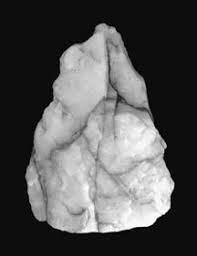
Unfortunately, we do not have enough evidence to follow this dispersal of Acheulean makers in more detail. Did hominins cross to Crete from Africa and then into Greece and Turkey? Or was the movement sometimes in the other direction, from Turkey and Greece to Crete? Perhaps in both directions? Will a Lower Palaeolithic presence be confirmed on Cyprus, Sicily, Malta, or the Balearics? To answer these and other questions raised by the discovery of the Cretan Acheulean, new research must be directed towards the elucidation of the Palaeolithic record on that island as well as on other large islands that were separated from the mainland during the Pleistocene and accessible to early hominins only by boat. The presence of Lower Palaeolithic artifacts on Cyprus, the Cycladic islands, and, farther west on Malta and the Balearics appears to us to be likely, and we would also urge the reconsideration of the evidence from Sicily, Sardinia, and Corsica.
(Source: “Lower Palaeolithic artifacts from Plakias, Crete: Implications for hominin dispersals”, by Curtis Runnels, Chad DiGregorio, Karl W. Wegmann, Sean F. Gallen, Thomas F. Strasser & Eleni Panagopoulou)
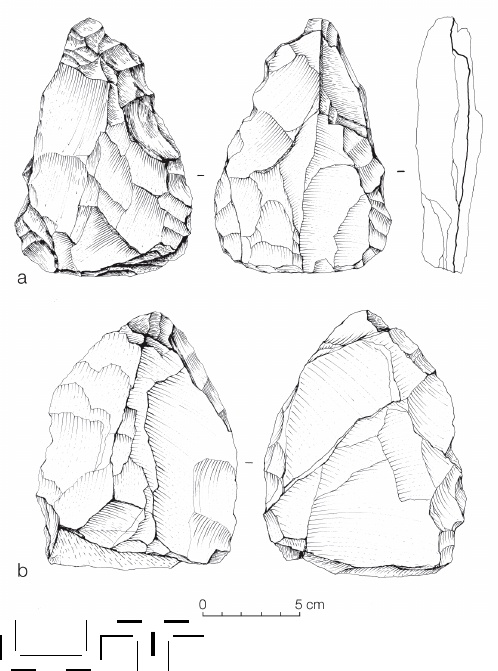
Abstract A survey in 2008 and 2009 on the southwestern coast of Crete in the region of Plakias documented 28 preceramic lithic sites. Sites were identified with artifacts of Mesolithic type similar to assemblages from the Greek mainland and islands, and some had evidence of Lower Palaeolithic occupation dated by geological contexto at least 130,000 years ago. The long period of separation (more than 5,000,000 years) of Crete from any landmass implies that the early inhabitants of Crete reached the island using seacraft capable of open-sea navigation and multiple journeys – a finding that pushes the history of seafaring in the Mediterranean back by more than 100,000 years and has important implications for the dispersal of early humans.
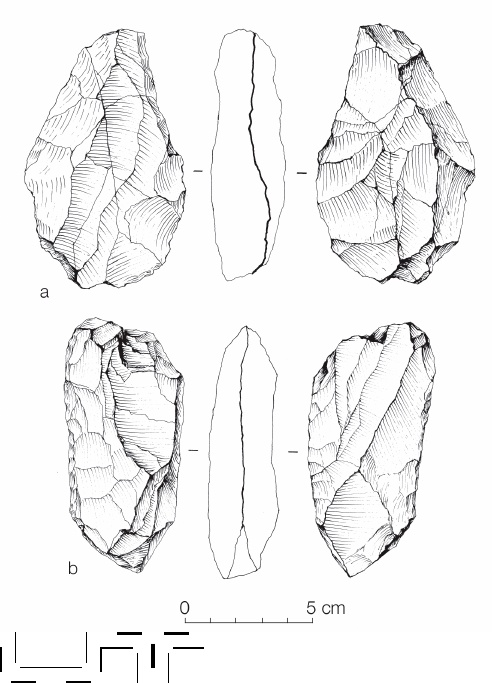
Conclusions The purpose of the Plakias Survey was to demonstrate that foragers were exploiting the coastal resources of Crete in the early Holocene, ca. 9,000-11,000 years ago, and this goal has been achieved. The additional discovery of Lower Palaeolithic sites points to an early period of seafaring in the Mediterranean, beginning at least 130,000 years ago, if not considerably earlier, with important implications for the colonizing of Europe by early African hominins.
Based on the available data – and we stress that research is ongoing – the most parsimonious hypothesis is that the exploitation of coastal and estuarine wetland resources of the Plakias region took place in both the Pleistocene and early Holocene, and that two separate human groups left traces of their existence in this region, one in the Middle to Upper Pleistocene (ca. 130,000 b.p. or earlier), and the other in the late Pleistocene-early Holocene (ca. 11,000-9000 b.p.).
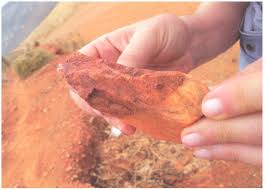
A minimum of 20 Mesolithic sites are preserved in the area between Preveli and Damnoni where they are associated with caves and rockshelters. Only traces of Mesolithic activity were found around Ayios Pavlos. The Mesolithic lithic industry is similar in typological and technological terms to Mesolithic industries found elsewhere in Greece. The sites in the survey area are currently unexcavated and undated, and we cannot yet determine whether they were occupied for all or only part of this chronological span.
The sites near Plakias are generally small, and their probable function in the landscape may have been as logistical camps or local extraction sites. Schinaria 1 is a candidate for a repeatedly visited site or a residential base because the assemblage is rich in cores and displays a variety of tool types. Given the many other sites of this period in the survey area, it seems likely that we are looking at the exploitation of this region by Mesolithic foragers who utilized a logistical collecting strategy similar to that recognized in the Argolid on the mainland.60 The concentration of sites around the coastal wetlands is also consistent with the hypothesis that early foragers focused their subsistence efforts on the exploitation of coastal wetlands. But did they investigate, or settle, the higher elevations of the rugged mountainous interior? Were the Mesolithic maritime foragers seasonal visitors or permanent inhabitants? Did they have an impact on endemic flora and fauna? At present, we cannot answer these questions.
The Lower Palaeolithic sites are found between Preveli and Schinaria at elevations between 40 and 200 masl where they are associated with marine terraces, paleosols, and debris flow fans. Although found in the vicinity of caves and rockshelters, none of the known sites remain undisturbed and little can be said about their original contexts. Periods of uplift and marine transgression affected the coast throughout the Upper Pleistocene and may have interfered with the preservation of such materials.

Where did the Plakias Palaeolithic originate? On the present scanty evidence, an African or Near Eastern origin is as likely as an Anatolian or mainland Greek one. Wherever it originated, the Plakias Palaeolithic has implications for our understanding of hominin dispersals. It has long been thought that the Acheulean reached Europe via the Near East, passing through Anatolia, and through the Iberian peninsula directly from Africa, perhaps carried by Homo erectus or Homo heidelbergensis populations. In this context, Palaeolithic archaeological sites and a newly discovered fossil Homo erectus calvaría in Turkey can be cited as support. This view of the peopling of Europe exclusively by land clearly needs to be rethought in light of the Cretan evidence presented here. While early hominins may have reached Anatolia via the Near Eastern corridor, it is apparent that there could have been sea routes crossed and recrossed by long-distance seafarers moving at will throughout the Mediterranean.
Once early hominins reached Crete, was their exploitation of the region continuous or intermittent? Did early hominins find their way into the interior, or did they remain confined to the coast? What effect did they have on the endemic flora and fauna? As with the Mesolithic, these questions must remain for the moment unanswered, and it is evident from the richness of the finds and the limited survey area explored to date that a great deal more research must be done on the island. Many areas rich in wetland resources in the Pleistocene and early Holocene existed on Crete and there are areas where extensive Pleistocene paleosols can be seen, for example, west of Chania. Crete is a large island with rugged relief, and much fieldwork is necessary to understand the extent of the prehistoric record and to gauge properly the impact of early human presence there. The new discoveries presented above compel us to consider the full significance and potential impact of early seafaring on the peopling of the Mediterranean, Europe, and the wider world.
(Source: “Stone age seafaring in the Mediterranean: Evidence from the Plakias Region for Lower Palaeolithic and Mesolithic Habitation of Crete”, by Thomas F. Strasser, Eleni Panagopoulou, Curtis N. Runnels, Priscilla M. Murray, Nicholas Thompson, Panayiotis Karkanas, Floyd W. McCoy and Karl W. Wegmann)
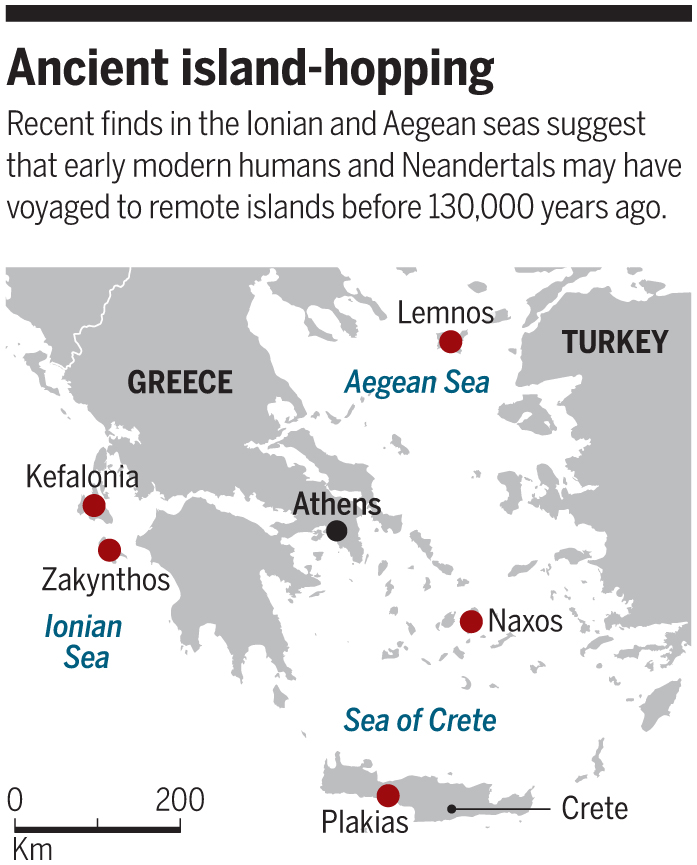
Research-Selection for NovoScriptorium: Philaretus Homerides

All this is very compelling. So far as I am aware there is no parallel evidence for sea travel to Cyprus before 8 KBC. Is that your understanding? If so, how can there be a 100,000 year gap. That is rather a long time, even with sparse populations.
LikeLike
Thank you for commenting. Before anything else, Crete lies in the Aegean region while Cyprus lies near the coasts of Southern Anatolia and the Middle East. The sea environment was and is quite different between these two regions. For instance, even before ~ 10.000 years the sea-level in the Aegean had been around 200-300 metres lower than today. It had always been far easier for the inhabitants of the Aegean to move with primitive rafts from one small or big island to the other due to short distances, and so they educated and evolved themselves as such for millenia. As for Cyprus, excavations of the last 20 years have shown that the island had Aegean influence already since the 12th millenium BC. To conclude this short (and surely not complete) answer, seafaring had been evolving in the Aegean for countless millenia; at some point, for reasons that are still under discussion and research, the Aegeans attempted (with success) to move from the Aegean to more open seas (oceanic environment) and, of course, one of their first destinations had been the island of Cyprus (among many other destinations, like e.g. Malta during the Neolithic). Cheers.
LikeLike
Thx very much for your reply. It was very helpful. The source I have been using for Med Sea levels (https://en.wikipedia.org/wiki/Early_Holocene_sea_level_rise) cites 10kyrsea levels as 80 – 100 m lower than today making Cyprus a boat trip. Your data would make it perhaps still a boat trip but a much shorter (and more feasible) one. I would love any sources you are comfortable in sending along. I have also been seeking references to early rafts/boats in the 10th – 12th millennium BC but have not found any. Again if you have sources, I would very much appreciate a reference. I assume there were boats in Europe’s rivers well before this, but have found no references. Best wishes
LikeLike
Thank you for your reply. You may be interested to read the following posts. Hopefully, you’ll find them helpful; 1) https://novoscriptorium.com/2020/12/03/obsidian-dating-provides-proof-for-naval-trade-in-the-aegean-during-the-late-pleistocene-early-holocene-13-10000-ybp/ , 2) https://novoscriptorium.com/2020/12/10/the-mesolithic-neolithic-aegeans-must-have-had-proper-ships-and-not-just-primitive-rafts-and-canoes-a-crucial-find-from-franchthi-cave/ , 3) https://novoscriptorium.com/2021/01/23/flooding-events-in-the-aegean-c-9300ybp-7600ybp-the-myth-confirmed-by-modern-science-direct-and-indirect-implications/ , 4) https://novoscriptorium.com/2021/02/16/climate-instability-in-the-ancient-aegean-sea-modern-science-suggests-a-series-of-cataclysmic-events-during-the-early-holocene/ , 5) https://novoscriptorium.com/2021/01/29/evidence-for-mesolithic-maritime-connectivity-between-the-inhabitants-of-crete-and-the-cyclades-implications-of-the-findings/ , 6) https://novoscriptorium.com/2021/01/30/the-importance-of-the-aegean-mesolithic-the-implications-of-the-most-recent-findings-no-massive-migration-from-the-east-appears-to-have-been-responsible-for-the-neolithization-of-the-g/ , 7) https://novoscriptorium.com/2020/12/29/the-western-expansion-of-the-neolithic-aegeans-greek-mythology-confirmed-by-modern-science-direct-and-indirect-implications/ , 8) https://novoscriptorium.com/2020/11/24/greek-myths-contain-information-from-the-neolithic-age-an-example-from-pindar/
LikeLike
Wow! Wonderful. Looks like I have some homework to do. I very much look forward to it. Assuming all this is correct, it also seems to me that boats are among (or arguably “be”) mankind’s earliest innovation. There are certainly examples from the Indo-Pacific in this time period, but I had not seen anything in Europe (Eastern or Western) so this is fascinating for me. Thx very much.
LikeLiked by 1 person
This is a super helpful reply. Why this very clear point had not stood out for me before, I cannot guess. But now that you have pointed it out it is very clear. Thanks very much.
Now the next question is, since the Dardanelles is about 55m deep, was the Black Sea a lake for a (very) long period of time, or was it always connected to the Aegean? If a lake, what do we know about human migrations from west of the Black Sea to the south of the Black Sea. Lots of migration through the Caucacus but what about the other possible route?
LikeLike
https://novoscriptorium.com/2021/01/23/flooding-events-in-the-aegean-c-9300ybp-7600ybp-the-myth-confirmed-by-modern-science-direct-and-indirect-implications/ , and, https://novoscriptorium.com/2021/03/19/aegean-thrace-early-neolithic-sites-that-once-may-have-existed-on-the-coastal-plain-either-rest-on-the-seabed-today-or-they-have-been-lost-to-the-sea/ , should give you a first -and good- answer. Cheers!
LikeLike
Thx very much. Greatly appreciated.
LikeLiked by 1 person